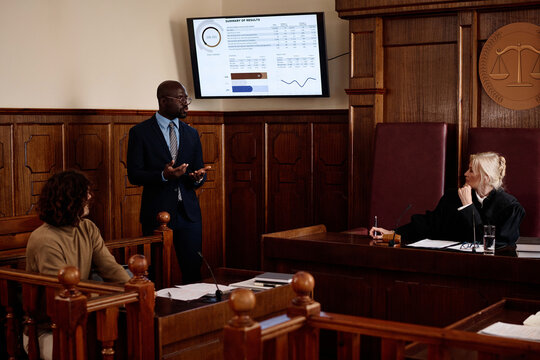Browsing the Complexities of Trial Presentations: Tips for Seamless Shipment and Compelling Debates
In the realm of lawful procedures, the art of test presentation stands as a crucial component of success. As attorneys browse the elaborate internet of court characteristics, the capability to seamlessly provide arguments and evidence while astounding the jury's focus becomes extremely important. The complexities integral in trial presentations call for a delicate equilibrium of skill, finesse, and approach. By sharpening techniques that make sure a polished delivery and crafting engaging debates that reverberate with the audience, lawyers can significantly improve their campaigning for. In a globe where persuasion reigns supreme, mastering the ins and outs of test discussions is not merely an option however a requirement for those looking for to dominate in the courtroom.

Understanding Trial Goals
To properly browse a trial, it is important to have a clear understanding of the goals that require to be attained. Before stepping into the court, legal groups have to specify their objectives and desired outcomes. These objectives work as directing concepts throughout the test, forming approaches and affecting decision-making procedures.
Recognizing test purposes entails a comprehensive analysis of the case, legal precedents, and the client's benefits. Trial Presentations. It requires a meticulous examination of the facts, identifying key issues, and anticipating potential challenges. By establishing details and quantifiable goals, attorneys can tailor their debates and discussions to line up with the desired results
In addition, a clear grip of test goals enables lawful groups to prioritize evidence, witnesses, and lawful disagreements successfully. It permits the development of a systematic story that resonates with the discretionary, enhancing the overall instance discussion.

Organizing Proof Efficiently
Having a clear understanding of trial purposes lays the foundation for arranging evidence effectively in lawful proceedings. By straightening the presentation of proof with the desired end results of the trial, lawful teams can reinforce their arguments and boost their persuasiveness.
One more crucial element in organizing proof effectively is establishing a sensible flow. Offering evidence in a sequential and systematic manner can assist build a compelling story that supports the legal debates being made. Additionally, utilizing aesthetic aids such as timelines, graphs, or charts can better enhance the organization of evidence and assist in clarifying complicated relationships or sequences of occasions.
Furthermore, making sure that all proof offered is acceptable and appropriate to the case is necessary. Unnecessary or inadmissible evidence can take away from the toughness of the debate and potentially harm the trustworthiness of the offering party. For that reason, a careful testimonial and option procedure need to be undertaken to include only the most impactful and legally sound evidence in the trial presentation.
Crafting Convincing Narratives
Crafting compelling stories plays a critical duty in providing persuasive debates during lawful procedures. When creating a narrative for a test presentation, it is essential to develop a clear storyline that highlights vital points and attaches them in a coherent fashion. By weaving together proof, testimony, and lawful arguments into a influential and cohesive story, legal experts can effectively promote for their customers and enhance the probability of a favorable result in the court room.
Grasping Aesthetic Aids
Efficient usage of visual aids is vital to enhancing the effect and quality of test presentations. Visual help, when made use of strategically, have the power to simplify intricate details, reinforce bottom lines, and leave a lasting impression on the discretionary. To understand aesthetic aids in trial presentations, it is vital to make certain that they are clear, concise, and relevant to the disagreements being made.
When integrating aesthetic help, such as graphes, photos, charts, or timelines, right into a test discussion, it is necessary to maintain them visually appealing yet expert. The visuals should match the spoken disagreements, supplying a visual representation of the information being gone over without frustrating the audience with unnecessary details.
Moreover, experimenting the aesthetic aids beforehand is crucial to make certain a smooth distribution throughout the trial. Familiarizing oneself with the content, changes, and timings of each visual help can aid preserve the circulation of the discussion and protect against technical glitches that might emerge.
Delivering Impactful Closing Arguments
An visit here engaging closing debate serves as the end result of a test presentation, enveloping the core story and encouraging the judge and jury towards a desirable decision. Begin by describing the major disagreements that sustain your client's setting, emphasizing why the evidence offered throughout the trial supports your story.
Furthermore, including sob story can better enhance your closing debate. By humanizing the case and linking on a personal degree with the decision-makers, you can stimulate empathy and visit here understanding, influencing their assumption of the realities presented. Furthermore, stating the legal standards that need to find more be fulfilled for a favorable ruling can strengthen the legitimacy of your placement. Ultimately, a well-crafted closing argument ought to leave an enduring impact, compelling the discretionary to rule in your client's favor.
Final Thought
In verdict, understanding test discussions includes comprehending goals, organizing evidence, crafting narratives, utilizing visual aids, and supplying impactful closing debates. By applying these approaches properly, legal representatives can offer their instance effortlessly and make compelling arguments in the courtroom. It is essential to navigate the intricacies of test presentations with precision and ability to attain success in lawful procedures.
By aligning the discussion of proof with the preferred outcomes of the test, lawful teams can strengthen their debates and improve their persuasiveness (Trial Presentations). To grasp visual help in trial presentations, it is critical to make certain that they are clear, concise, and relevant to the debates being made
An engaging closing argument offers as the conclusion of a trial discussion, encapsulating the core story and convincing the judge and court towards a favorable choice. Begin by detailing the main disagreements that support your client's setting, emphasizing why the proof provided throughout the test supports your story.In final thought, mastering trial discussions includes understanding goals, organizing proof, crafting narratives, using visual help, and delivering impactful closing disagreements.